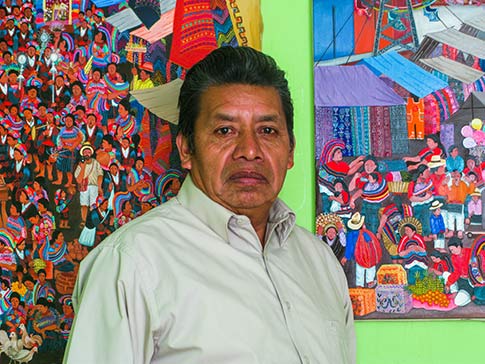The Paintings of
Margarito Chex Icú
Artist Biographies
San Juan Comalapa
Salvador Cúmez Curruchich
Rosa Elena Curruchich
Maria Elena Curruchiche
Margarito Chex Icú
Paula Nicho Cúmez
Margarito Chex Icú
By Joseph Johnston
Margarito Chex Icú began painting in 1961 at the age of sixteen. As was typical of men of his generation, he had little schooling, only completing the second grade.
His painting style is quite different than the style developed by the Tz’utuhil Mayan artists. The colors are bright and pure with no shading. His figures are always tiny. If the painting is large, the figures are not much larger, there are just more of them. His large paintings are a tour de force, with hundreds of individual figures, and a riot of color and pattern. He prefers painting market days or fairs and likes to paint several different towns with distinctive traje (traditional handwoven attire): his own town of San Juan Comalapa, Santa Cruz del Quiche, Chichicastenango, Sololá, and Santiago Atitlán. He usually includes the colonial catholic church building in his compositions. Although composition of the painting for each town remains pretty much the same, he varies the people and their activities making each painting unique. One of the distinctive characteristics of his fairs are the multicolored hot-air balloons in the sky overhead. In paintings of the market place in Chichicastenago, you will find among all the Maya people, one tourist with a camera.

Margarito Chex Icú stands in front of two of his large paintings. A fair in his town of San Juan Comalapa is on his right and market day in Chichicastenango is on his left. Over his left shoulder is the figure of a lone tourist with a camera among all the Maya at the market.